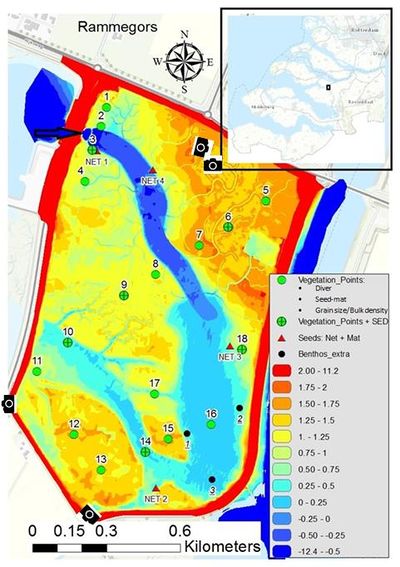
The vegetation monitoring focused typifying vegetation communities, seed limitation, soil chemistry and drainage. The results show that fresh water vegetation is retreating and being replaced by the intertidal vegetation. There is a substantial die-off of fresh-water vegetation such as reed and grass in the inundated areas. The vegetation is replaced by salt-water species as Salicornia and Aster. Furthermore, it is concluded that there is no seed limitation. Floating nets and seed traps show a huge availability in vital seeds of Aster, Salicornia and reed. Furthermore, the compaction of the mature soil did not change in the last three monitoring years due to the new inundation regime. Dead organic material had no noticeable influence on the redox and sulfide concentration in the pore water of the top 10 cm in sediment. Hence, the die off of the fresh-water vegetation probability did not impact the establishment of salt-marsh vegetation in any way. The mesocosm experiment shows that poor drainage has a negative effect on seedling survival. The most important parameter for tidal recovery projects coming out of the seedling survival experiment is the bed elevation and its corresponding inundation time. For seed survival, the inundation time optimum seems to be between 50 and 95% dry time.
- Rammegors tidal restauration, final report, Lageweg, W. van de et al., Centre of Expertise Delta Technology, april 2019.
Zie ook
- Rammegors tidal restauration, final report
- Perkpolder tidal restauration, one year after realisation, draft progress report
- Perkpolder Tidal Restauration
- Biogeomorphology of Spartina anglica tussocks, GIS based comparison of contrasting sites at the Westerschelde and Blackwater estuary
- Wadden Sea Plan 2010
- Short-term mudflat dynamics drive long-term cyclic salt marsh dynamics.
- Building with Nature; from concepts to practice
- Eelgrass seed dispersal via floating generative shoots in the Dutch Wadden Sea: a model approach
- The effects of biogeochemical stressors on seagrass ecosystems
- Development of the benthic macrofauna community after tidal restoration at Rammegors






